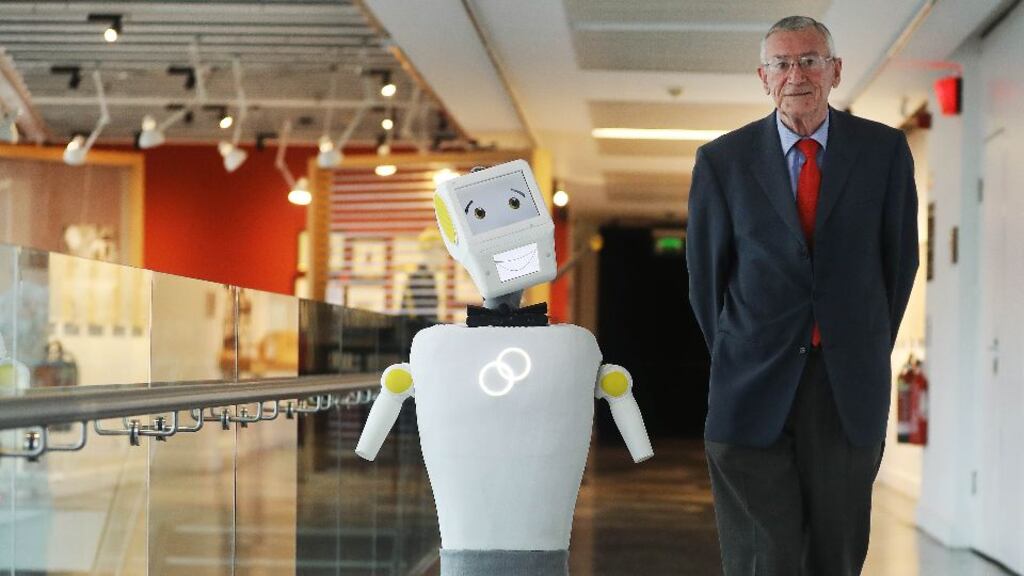Older people and their caregivers in Ireland may soon be able to benefit from the assistance of a specially designed robot called Stevie. Developed by a team at Trinity College Dublin, Stevie will be able to perform a range of routine work tasks which will take the load off caregivers, while it will also be able to have conversations with users, and perhaps even be a source of entertainment.
This is an example of the augmented workforce. This concept sees the deployment of a range of technologies, including artificial intelligence, big data analytics, advanced sensors and telemetry, and robotics – not to replace people’s jobs in their entirety but to assist them in their day-to-day work.
In the future, production-line workers will be assisted by robots with advanced machine vision which will detect faulty products far quicker than any human could, while vast swathes of routine office work will be replaced by increasingly sophisticated software algorithms.
[
[ To book tickets for Talent Summit 2018, visit talentsummit.ieOpens in new window ]
]
The day of the digital PA may not be too far distant. In fact, many of us are already using them in our homes in the form of the Amazon Echo and similar devices which can carry out many tasks such as controlling central heating, setting alarms, or playing your favourite music.
In the world of work, several news organisations are already producing sports and other stories using smart programmes and data collected by other automated systems, with surprisingly good results. This will not replace the role of the on-the-spot sports or political reporter or analyst but it will almost certainly take away some of the more routine tasks.
In the financial services world, we are seeing the rise of the robotic investment adviser, or robo-adviser. These electronic advisers have grown in popularity quite dramatically, with investors attracted by the ultra-low cost and speed. Robo-advisers allow investors to set up diverse portfolios tailored to their particular needs and tastes within minutes and offer access to wealth-management services previously reserved for the rich and famous.
Ireland is at the forefront of developments in this area. The team behind Stevie is leading the development of robots and artificial intelligence designed to perform assistive tasks for human users and recently secured significant development funding from Enterprise Ireland to advance the research towards a marketable model via a new start-up company.
Stevie has been developed to address healthcare challenges, such as helping older people to remain independent and reducing the workload for caregivers in nursing homes and hospitals. “Care facilities face significant challenges, especially during the night when caregiver-to-resident ratios are low,” says Conor McGinn, assistant professor in the School of Engineering at Trinity. “Our solution can perform several routine tasks, which will improve efficiency and substantially alleviate pressure on care staff during periods when the facility may be understaffed.”
Stevie is already at prototype stage and was unveiled to the public last year. The friendly looking robot has some human-like features and is able to perform a number of autonomous tasks and some that are human-controlled.
The technology is being developed to augment, not replace human work
Stevie has a similar form to a person, as it possesses two arms and a “head” interface that allows it to provide social feedback to people working in its vicinity. Sounds, lights, facial expressions and body language help it to communicate and respond appropriately to different situations.
The robot is mobile and uses cameras, as well as depth, laser, tactile, and inertial sensors to interact intelligently with its environment, while on-board processors and wireless connectivity including wifi and Bluetooth diversify its potential uses. In addition to performing functional tasks, the robot can interact socially with users.
“The social interaction that is possible with the robot brings many benefits,” explains McGinn. “First, it provides a compelling way to reduce boredom and stimulate mental activity. It can have basic conversations with its users and play a series of simple games, and on a grander level, it can function as a control interface with many different types of technology. For example, through natural interaction with the robot, people can control the TV stations, call a loved one, and control lights.”
Stevie’s inventors have ambitions beyond the healthcare domain. The team believes the robot is well suited to performing many undesirable jobs and where companies struggle to find the right staff, such as those which involve anti-social hours.
“The technology is being developed to augment, not replace human work,” McGinn emphasises. “We are working closely with end users, leading experts and organisations to develop a solution that empowers people.”
The team is currently in talks with several major companies and organisations across a range of industries including healthcare, assisted living, hospitality, retail and banking. Over the next two years, the team will pilot the technology extensively in Ireland, Europe and the US. It is hoped Stevie will be fully market-ready by 2021.











